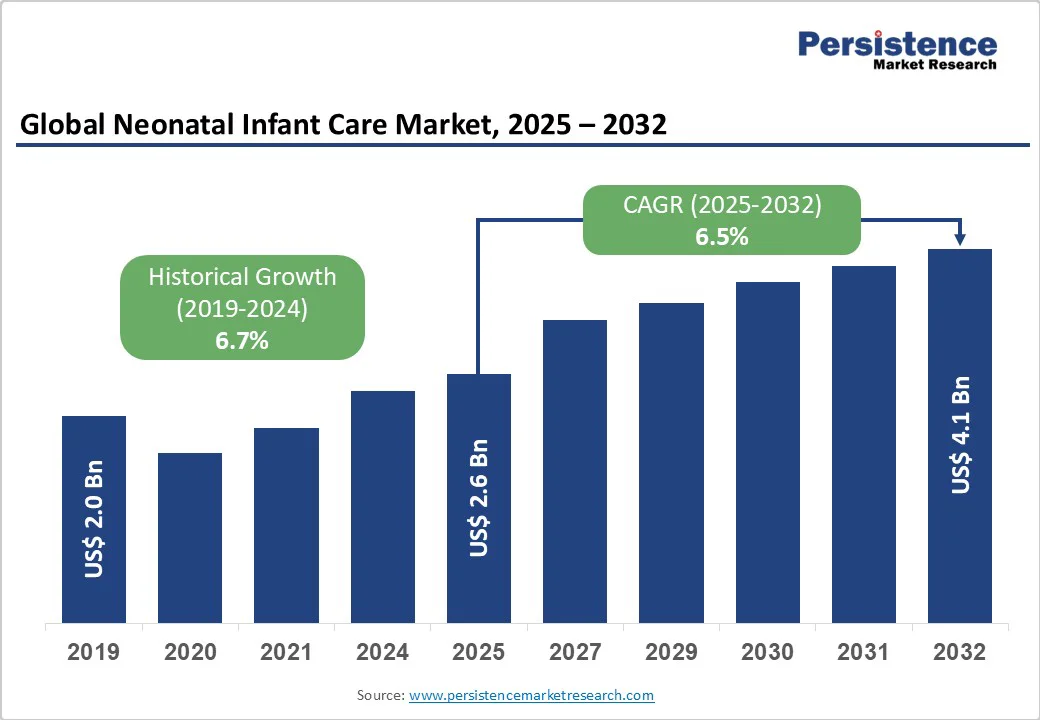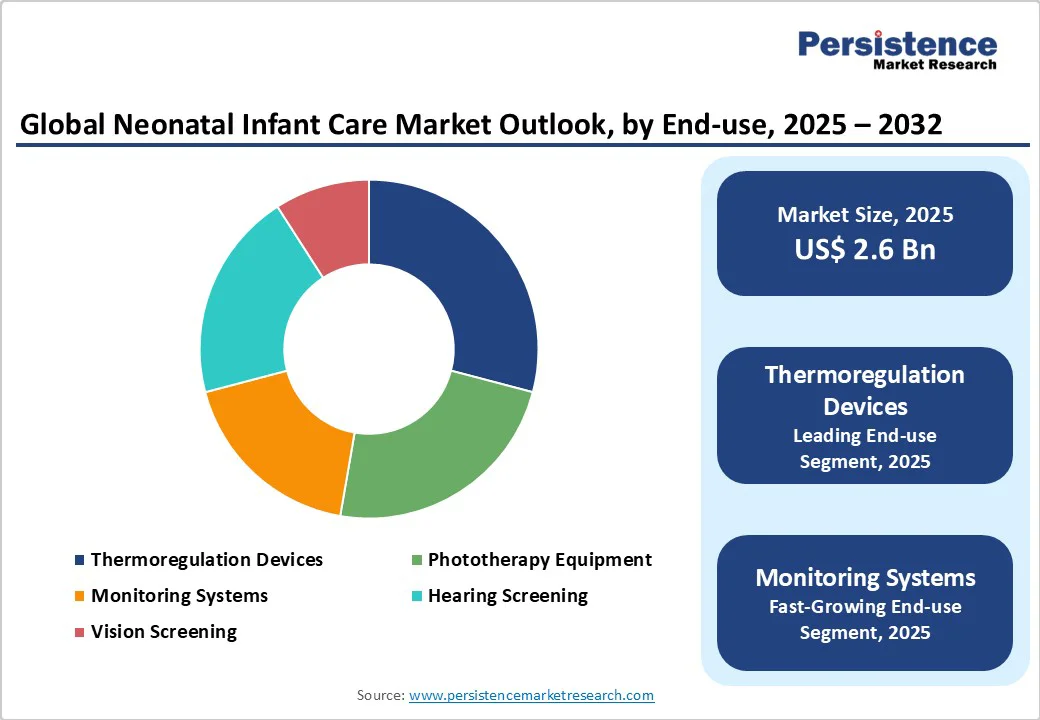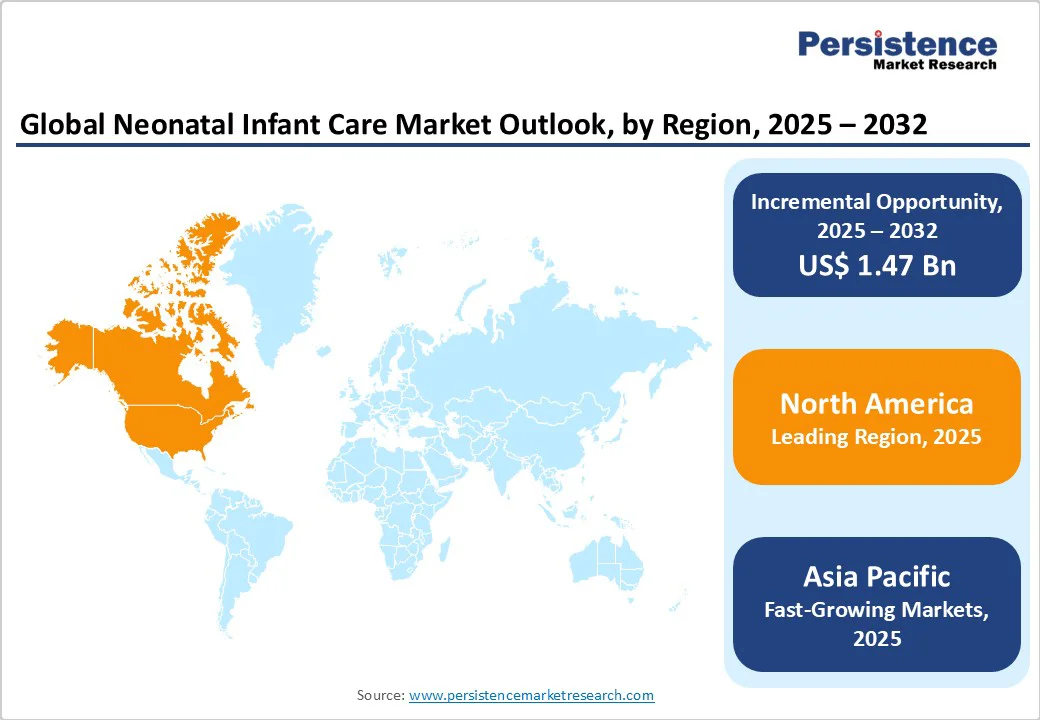ID: PMRREP4157| 207 Pages | 27 Oct 2025 | Format: PDF, Excel, PPT* | Healthcare

The global neonatal infant care market size is likely to be valued at US$2.6 Billion in 2025 and is expected to reach US$4.1 Billion by 2032, growing at a CAGR of 6.5% during the forecast period from 2025 to 2032, driven by rising preterm birth rates, increasing neonatal mortality awareness, and advancements in neonatal intensive care technologies. Demand for incubators, warmers, and phototherapy units is rising in hospitals and home care settings. IoT and AI-enabled monitoring enhance real-time infant tracking and outcomes. Emerging economies are investing in advanced NICU infrastructure, while developed regions prioritize portable, non-invasive devices.
| Key Insights | Details |
|---|---|
|
Neonatal Infant Care Market Size (2025E) |
US$2.6 Bn |
|
Market Value Forecast (2032F) |
US$4.1 Bn |
|
Projected Growth (CAGR 2025 to 2032) |
6.5% |
|
Historical Market Growth (CAGR 2019 to 2024) |
6.7% |

The rising survival rate of extremely preterm infants, those born before 28 weeks of gestation, is a major driver for the neonatal infant care market. Advances in neonatal technology, such as precision thermoregulation systems, high-frequency ventilators, and AI-enabled monitoring, have significantly improved the ability to sustain these fragile newborns.
Innovations in micro-sensor technology and gentle respiratory support allow for early stabilization and continuous monitoring without invasive procedures. The growing number of tertiary care hospitals equipped with advanced NICUs is expanding access to such treatments, particularly in developed regions. As more premature infants survive critical early weeks, the need for specialized, long-term neonatal care devices continues to rise, fostering ongoing investments and product innovation across the industry.
A major challenge restricting the growth of the neonatal infant care market is the lack of well-equipped neonatal intensive care units (NICUs) in many developing regions. Hospitals in rural and semi-urban areas often operate with minimal infrastructure, lacking essential facilities such as temperature-controlled rooms, advanced incubators, and continuous monitoring systems. This insufficiency limits the ability to provide critical care for preterm and low-birth-weight infants, who are highly vulnerable to hypothermia and other complications.
Outdated or overcrowded NICUs reduce the efficiency of neonatal interventions and compromise patient outcomes. The scarcity of specialized equipment and trained neonatal healthcare professionals further exacerbates the problem, creating a significant barrier to improving survival rates in these regions.
AI-powered predictive monitoring represents a transformative opportunity in neonatal care. By leveraging machine learning and advanced analytics, these systems continuously analyze vital signs, physiological parameters, and historical patient data to identify early warning patterns of complications such as sepsis, respiratory distress, or hypothermia. This proactive approach enables clinicians to intervene before critical symptoms emerge, improving survival rates and reducing long-term health issues.
Integration with NICU monitoring systems and cloud-based platforms allows real-time alerts, remote consultations, and data-driven decision-making. As hospitals increasingly adopt precision medicine, AI-driven predictive neonatal monitoring can redefine infant care, optimize resources, and enhance clinical outcomes globally.
Thermoregulation devices lead the market since maintaining stable body temperature is crucial for newborn survival, especially for preterm and low-birth-weight infants who lack sufficient thermal regulation. Incubators, radiant warmers, and cooling systems are indispensable in NICUs, providing a controlled environment that minimizes hypothermia-related complications such as respiratory distress, infections, and delayed growth.
High adoption in hospitals, continuous product innovations such as servo-controlled and energy-efficient devices, and integration with monitoring systems further reinforce their prominence. The rising global preterm birth rates, increasing awareness of neonatal mortality, and expanding NICU infrastructure in emerging markets drive sustained demand, making thermoregulation devices not only essential but also the highest revenue-generating and widely implemented product segment in neonatal care.
Hospitals, particularly those with Neonatal Intensive Care Units (NICUs), account for the highest adoption of neonatal care devices as they handle the majority of high-risk, preterm, and critically ill infants. These facilities require advanced equipment such as incubators, phototherapy units, monitoring systems, and resuscitation devices to manage complex neonatal cases. The high patient inflow, continuous need for specialized care, and large-scale infrastructure investments in hospitals drive their dominance over pediatric clinics and nursing homes, making them the primary revenue contributor and largest consumer segment in the neonatal infant care market globally.

North America, led by the U.S., remains the dominant region in the neonatal infant care market due to advanced healthcare infrastructure, high-quality NICUs, and strong government support for maternal and child health programs. The region benefits from widespread adoption of technologically advanced devices, including AI-enabled monitoring systems, servo-controlled incubators, and phototherapy units, ensuring superior neonatal outcomes.
Rising awareness of preterm birth complications, coupled with increasing healthcare expenditure, drives demand for comprehensive neonatal care solutions. North America sees significant investments in R&D, fostering innovative, non-invasive, and portable neonatal devices. The presence of leading manufacturers and stringent regulatory standards further reinforces market growth, making the U.S. and broader North American region a global hub for cutting-edge neonatal infant care solutions.
The Asia Pacific neonatal infant care market is emerging rapidly, driven by increasing birth rates, rising preterm and low-birth-weight infants, and expanding healthcare infrastructure in countries such as China, India, and Southeast Asia. Growing awareness of neonatal mortality and government initiatives to improve maternal and child health are boosting demand for NICUs and advanced neonatal devices.
Hospitals are increasingly adopting thermoregulation systems, phototherapy equipment, and monitoring devices, while portable and cost-effective solutions gain traction in rural and semi-urban areas. Rapid urbanization, rising disposable incomes, and collaborations between global device manufacturers and local healthcare providers further propel growth. With continuous investments in technology and training, Asia Pacific is poised to become a key growth engine in the global neonatal care landscape.

The global neonatal infant care market is highly competitive, characterized by global and regional players focusing on innovation, strategic partnerships, and geographic expansion. Key companies invest heavily in R&D to develop advanced incubators, phototherapy units, and AI-enabled monitoring systems, enhancing device efficiency and safety.
Mergers, acquisitions, and collaborations with hospitals and healthcare institutions strengthen market presence and distribution networks. Differentiation through portable, energy-efficient, and non-invasive solutions drives competitive advantage. Emerging markets attract new entrants offering cost-effective neonatal devices, intensifying rivalry.
The neonatal infant care market is projected to be valued at US$2.6 Billion in 2025.
Increasing numbers of premature and low-birth-weight infants worldwide create a strong demand for specialized neonatal care.
The neonatal infant care market is poised to witness a CAGR of 6.5% between 2025 and 2032.
Key opportunities include the use of predictive analytics to forecast complications in newborns before symptoms appear.
GE Healthcare, Koninklijke Philips N.V., Medtronic plc, Becton and Dickinson and Company.
| Report Attribute | Details |
|---|---|
|
Historical Data/Actuals |
2019 - 2024 |
|
Forecast Period |
2025 - 2032 |
|
Market Analysis |
Value: US$ Bn |
|
Geographical Coverage |
|
|
Segmental Coverage |
|
|
Competitive Analysis |
|
|
Report Highlights |
|
By Product Type
By End-user
By Region
Delivery Timelines
For more information on this report and its delivery timelines please get in touch with our sales team.
About Author